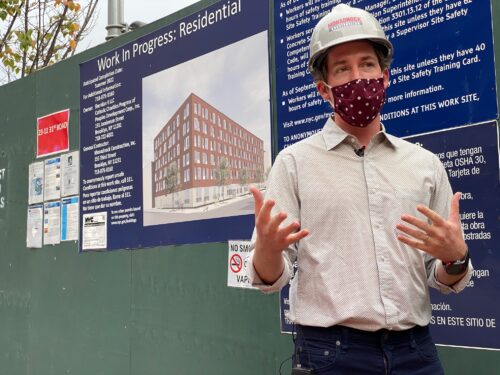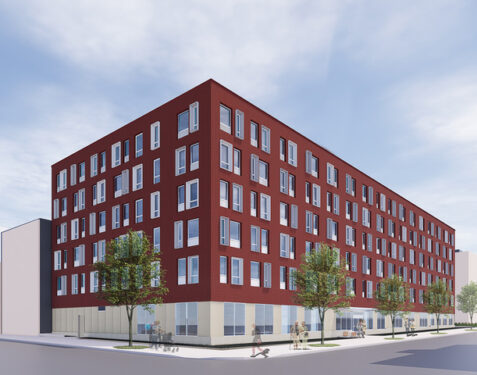By Emily Drooby and Bill Miller
ASTORIA — Construction of a new home for low-income people was about to start last spring in Queens, but the COVID-19 pandemic rattled all aspects of normalcy worldwide.
The Bishop Valero Residence, a project of Catholic Charities of Brooklyn and Queens, is expected to add 102 badly-needed apartments for seniors and formerly homeless adults. It’s located at 23-11 31st Road in Astoria, Queens.
Financing for this $62 million effort depended on several partners, including the New York City Department of Housing Preservation and Development (HPD). The pandemic forced that agency to cut back on its budget by 40 percent for the rest of 2020, plus next year, according to David Downs, the deputy director of Catholic Charities’ Progress of Peoples Development Corporation.
The project’s partners, realizing its importance, did not give up.
“All the players chipped in to make the project work in the time frame we needed,” Downs said. “A lot of people had to make some concessions and be flexible.”

For example, Downs said Catholic Charities and the city agreed to add more financing. The city’s portion of the funding was key because it involved $3.1 million in low-income housing tax credits (LIHTC), which are expected to generate $30.8 million in equity over 15 years, nearly half of the money needed to build the project.
Other partners include Bank of America, Richman Housing Resources, and Barings, LLC. Dattner Architects designed the project and Monadnock Construction is the builder.
Although the project’s closing was a few weeks late, construction started on time in June, which was a great relief, according to Downs.
“We had our construction budget in place, but we could only guarantee costs through June,” he said. “Supply was a big concern for building materials like steel. So there was a lot of pressure on the team.
“We had a calm exterior, but on the inside, we were very nervous.”
Affordable Housing Shortage
The Progress of Peoples Development Corporation started making affordable housing in the 1970s — serving families, formerly homeless people, senior citizens, and people with HIV.
The task has only gotten harder as New York City’s population swelled to about 8.6 million people, the biggest of all U.S. metropolitan areas. The city’s expensive real estate market adds even more hurdles for land acquisition.
Tim McManus, vice president of Progress of Peoples Development Corporation, said a 2016 study showed there were 200,000 applicants for 20,000 affordable housing units in New York City.
“Demand for senior affordable housing is a mess throughout the city,” McManus said. “We don’t have numbers to suggest what’s happened since COVID, but we know that number has grown.”
The Bishop Valero Residence is the second affordable housing project from Catholic Charities to start in 2020. In January, ground broke on the eight-story, 135-unit Catholic Charities Loreto Apartments on Sackman Street in the Brownsville area of Brooklyn.
This site is the former address of Our Lady of Loreto Church, which was demolished in 2017. Nearby is the Catholic Charities Monsignor Anthony J. Barretta Apartments, which was opened in 2013 on the former site of Our Lady of Loreto School.
The Brownsville project began a few weeks before the pandemic’s onset in March and continued uninterrupted.
However, projects planned by other developers are not as fortunate, being stuck in a COVID-wrought financing limbo, adding to the frustration of advocates struggling with an existing shortage of affordable-housing citywide.
“A lot of projects,” McManus said, “are still on the sidelines.”
Build a Community
The six-story Bishop Valero Residence is expected to open in 2022 with nearly 85,000 square feet of space and environment-friendly features like solar panels.
It’s located in a former parking lot for the existing Catherine Sheridan Senior Housing project, another property in the Progress of Peoples Development Corporation’s affordable-housing portfolio.

About 6,500 square feet are set aside for a ground-floor, 200-seat community center operated by Catholic Charities Neighborhood Services. Other amenities include a commercial kitchen serving hot meals, an exercise area, a computer lab, and a landscaped patio area.
“We build buildings we’d like to live in ourselves,” Downs said.
Of the 102 units, 71 are designated for low-income senior citizens, while the other 31 are for formerly homeless seniors. All residents will have access to on-site social services.
“We really are trying to put together a comprehensive model, providing not just for housing, but also social services to address the residents’ physical and social needs,” McManus said.
Father Patrick Keating, deputy chief executive officer of Catholic Charities of Brooklyn and Queens, explained that low-income tenants deserve safe homes, hopefully in the neighborhoods where they’ve lived and near their longtime parishes.
“What we try to do is build a community,” Father Keating said. “But it’s not just buildings; it’s a greater integration of bricks and mortar with services. All our programs are interconnected.”
Father Keating credited Msgr. Alfred LoPinto, chief executive officer, for devising a “holistic” approach to integrating services.
“The Church teaches the dignity of every single person,” Father Keating said, “and by providing a safe home, you’re serving that person, which allows us to fulfill our ministry.”